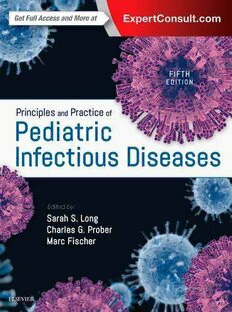
Principles and Practice of Pediatric Infectious Diseases PDF
Preview Principles and Practice of Pediatric Infectious Diseases
Principles and Practice of Pediatric Infectious Diseases FIFTH EDITION Editor SARAH S. LONG, MD Professor of Pediatrics Drexel University College of Medicine Chief, Section of Infectious Diseases St. Christopher's Hospital for Children Philadelphia, Pennsylvania 2 Associate Editors CHARLES G. PROBER, MD Professor of Pediatrics, Microbiology, and Immunology Senior Associate Dean for Medical Education Stanford University School of Medicine Stanford, California MARC FISCHER, MD, MPH Medical Epidemiologist Arboviral Diseases Branch Centers for Disease Control and Prevention Fort Collins, Colorado 3 Table of Contents Cover image Title Page Copyright Preface Acknowledgements Dedication Contributors Part I Understanding, Controlling, and Preventing Infectious Diseases A Epidemiology and Control of Infectious Diseases 1 Principles of Epidemiology and Public Health Descriptive Epidemiology 4 Analytic Epidemiology Vaccine Efficacy Studies Disease Control and Public Health Policy Evaluating the Medical Literature Acknowledgments References 2 Pediatric Healthcare Epidemiology Risk Factors for Healthcare-Associated Infections in Children Transmission Pathogens Prevention Programs References 3 Infections Associated With Group Childcare Childcare Settings Epidemiology and Etiology of Infections Vaccine-Preventable Diseases Infections Associated With Animals Infectious Diseases in Adults Economic Impact of Group Childcare Illness Prevention References 4 Infectious Diseases in Refugee and Internationally Adopted Children 5 Guidelines for Evaluation Preventive Measures References B Prevention of Infectious Diseases 5 Passive Immunization Immune Globulin (Human) Specific Immune Globulins for Intramuscular Administration Immune Globulin Intravenous (Human) Specific Immune Globulins for Intravenous Administration Monoclonal Antibodies Immunoglobulin Products Prepared From Animal Plasma Adverse Reactions to Immune Globulins Prepared From Human Plasma Product Shortages The Future References 6 Active Immunization Immunization and Vaccines: Overview Vaccine Development, Licensure, and Approval Principles of Immunization Programs Routine Childhood and Adolescent Vaccines Selected Other Vaccines That Can Be Used in Children and Adolescents 6 Sources of Information on Vaccines References 7 Antimicrobial Chemoprophylaxis General Principles Chemoprophylaxis in Healthy Children Chemoprophylaxis for Surgical Procedures and Trauma Chemoprophylaxis in Special Situations and in Children With Conditions Predisposing to Infection References 8 Protection of Travelers Preparation for Travel Malaria Travelers' Diarrhea Emerging Infectious Diseases Immunocompromised Travelers Return From Travel References C Host Defenses Against Infectious Diseases 9 Immunologic Development and Susceptibility to Infection Innate Immune Response Adaptive Immune Response Interrelationships and the Future 7 References 10 Fever and the Inflammatory Response Fever Inflammatory Response References Part II Clinical Syndromes and Cardinal Features of Infectious Diseases: Approach to Diagnosis and Initial Management A Septicemia, Toxin, and Inflammation-Mediated Syndromes 11 The Systemic Inflammatory Response Syndrome (SIRS), Sepsis, and Septic Shock Definitions Etiology Pathophysiology Clinical and Laboratory Findings Management Future Considerations References 12 Hemophagocytic Lymphohistiocytosis and Macrophage Activation Syndrome Hemophagocytic Lymphohistiocytosis 8 Etiology and Incidence Pathogenesis Clinical and Radiologic Features Laboratory and Pathologic Findings Diagnosis and Differential Diagnosis Treatment Prognosis Macrophage Activation Syndrome References B Cardinal Symptom Complexes 13 Mucocutaneous Symptom Complexes Specific Distinguishing Characteristics Diagnosis and Empiric Therapy References 14 Fever Without Localizing Signs Etiologic Agents Epidemiology Laboratory Findings and Diagnosis Management References 15 Prolonged, Recurrent, and Periodic Fever Syndromes 9 Fever of Unknown Origin Prolonged Insignificant Fever, Prolonged Illness With Resolved Fever, and Fatigue of Deconditioning Recurrent Fever and Periodic Fever Syndromes References 16 Lymphatic System and Generalized Lymphadenopathy Anatomy and Function of Lymphoid Tissue Developmental Changes Characteristics of Lymphadenopathy Pathogenesis of Lymphadenopathy and Lymphadenitis Histopathology of Lymphadenitis Lymphocutaneous and Oculoglandular Syndrome Infectious Causes of Generalized Lymphadenopathy Other Causes of Generalized Lymphadenopathy References 17 Cervical Lymphadenitis and Neck Infections Epidemiology Lymphatic Flow and Fascial Spaces of the Head and Neck Oculoglandular Syndrome of Parinaud Infectious Causes of Lymphadenitis Noninfectious Causes of Lymphadenopathy Neck Masses Not Involving Lymph Nodes Diagnostic Approach to Cervical Lymphadenopathy Management 10
